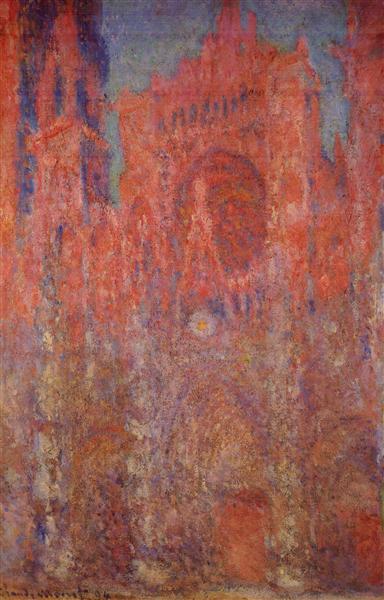Description
The "Ruan" Cathedral of Claude Monet, made in 1894, is a seminal work that represents the culmination of its exploration of color and light, in addition to being part of its ambitious project to capture the same subject at different times of the day of the day of the day and in various atmospheric conditions. Monet, central figure of impressionism, faces here one of the most emblematic monuments of Gothic architecture, the Ruan cathedral, a structure that attracted many artists of their time. However, it is the unique interpretation of Monet that offers us a radically different vision of the traditional framework of architecture painting.
In this work, Monet uses a composition that favors verticality, giving predominance to the haughty towers of the cathedral, which rise to the sky and are the visual center of the canvas. The texture and details of the stone are absent, but instead a masterful use of color is displayed; The blue, gray and lilac tones intermingle with light touches that seem to arise from the atmosphere itself. This chromatic meteorism becomes the essence of painting, where the effect of light is completely seized from the structure. Through loose and fast brushstrokes, Monet suggests luminosity instead of delineating precise shapes, revealing an abstract pictorial language that challenges the conventions of realism of its time.
The piece breathes a sensation of immediacy, as if Monet had captured an ephemeral moment in the life of the cathedral. This approach reflects his interest in visual perception and change, a way of addressing the painting that moved him away from traditional representation and brought him closer to a sensory experience in which the viewer is invited to feel instead of simply seeing. The sky surrounding the cathedral is full of nuances, suggesting the changing light of the day, which implies a passage of time and a continuous dialogue between the landscape and the light.
Unlike many classic works in which characters or narratives are found, "Ruan Cathedral" is explicitly avoiding the use of human figures, which could have been considered an essential component in the painting of their time. This narrative emptiness invites the viewer to contemplate the majesty of the cathedral in an almost mystical state, an interpretation of the sublime that transcends the mere architectural representation. The absence of human activity allows the focus to fall entirely into the building itself and its relationship with the immediate environment.
It is worth mentioning that this work is part of a broader series that Monet developed during his Ruan stay between 1892 and 1893, where he painted the cathedral at different times of the day. This project allowed him to explore the light phenomenon with greater depth, reflecting on how the same object can be transformed according to atmospheric conditions and time. The "Ruan Cathedral" is not only a representation of a beautiful building, but a deep study on light and its relevance in human visual experience.
In conclusion, "Ruan Cathedral" is a testimony of Monet's talent to turn light into color and printing structure, inviting viewers to get excited with almost ethereal breathing in the atmosphere. This radical approach prefigures many modern movements and continues to resonate in contemporary artistic practice, positioning Monet not only as a landscape painter, but as an innovative in the representation of perception. This masterpiece reflects the ethos of impressionism, where the search for light becomes the true protagonist, transforming the cathedral into an icon of change and temporality.
KUADROS ©, a famous paint on your wall.
Hand-made oil painting reproductions, with the quality of professional artists and the distinctive seal of KUADROS ©.
Reproduction service paintings With a guarantee of satisfaction. If you are not completely satisfied with the replica of your painting, we refund your money 100%.

